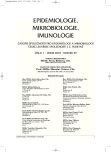Molekulární epidemiologie viru Varicella zoster
Autoři:
V. Boštíková 1
; P. Boštík 4; R. Chlíbek 1
; D. S. Schmid 2; M. Salavec 3; J. Smetana 1
; M. Špliňo 1
Působiště autorů:
Dpt. of Epidemiology, Faculty of Military Health Science, University of Defence, Hradec Králové, Czech Republic
1; Centers for Disease Control and Prevention, National Center for Immunizations and Respiratory Diseases, Atlanta, Georgia, USA
2; Dpt of Dermatology, Faculta Hospital, Hradec Králové, Czech Republic
3; Center of Advanced Studies, University of Defence, Czech Republic
4
Vyšlo v časopise:
Epidemiol. Mikrobiol. Imunol. 59, 2010, č. 1, s. 21-24
Souhrn
Varicela zoster virus (VZV) se vyznačuje vysoce konzervativním genomem, obsahujícím přibližně 125 000 nukleotidových párů bází.
Článek přehledně shrnuje vývoj molekulárně genetických přístupů zkoumání VZV v průběhu posledních deseti let. Autoři se zabývají výstupy těchto metod, jako jsou fylogenetické vztahy mezi jednotlivými kmeny VZV, jejich virulencí, geografickou distribucí, možnými rekombinacemi.
Klíčová slova :
varicela zoster virus – DNA genom – genotypová analýza – single nuclotide polymorphism (SNP).
Zdroje
1. Peters, G. A., Tyler, S. D., Gorse, C., Severini A. et al. A full-genome phylogenetic analysis of VZV reveals a novel origin of replication – based genotyping scheme and evidence of recombination between major circulating clades. J Virol 2006, 80, 9850-9860.
2. Rozenberg F., Lebon P. Amplification and characterization of herpes virus DNA in cerebrospinal fluid from patients with acute encephalitis. J Clin Microbiol 1991, 29, 2412-2417.
3. Clark P., Davidson, D., Letts, M., Lawton, L. et al. Necrotizing fasciitis secondary to chickenpox infection in children. Can J Surg 2003, 70, 961-963.
4. Arvin A. M. Varicella-zoster virus: overview and clinical manifestations Semin. Dermatol. 1996, 15, 4-7.
5. Norberg P., Liljeqvist, J. A., Bergstrom, T., Sammons, S. et al. Complete-genome phylogenetic approach to VZV evolution: Genetic divergence and evidence for recombination. J Virol 2006, 80, 9569-9576.
6. Dayan G. H., Panero, M. S., Debbag, R., Urquiza A. et al. Varicella seroprevalence and molecular epidemiology of varicella-zoster virus in Argentina. J Clin Microbiol 2004, 42, 5698-5704.
7. Loparev V. N., Gonzalez, A., Deleon-Carnes, M., Tipples, G. et al. Global identification of three major genotypes of VZV: longitudinal clustering and strategies for genotyping. J Virol 2004, 78, 8349-8358.
8. Sergeev N., Rubtcova, E., Wutzler, D., Schmid, S. D. et al. New mosaic subgenotype of varicella-zoster virus in the USA. VZV detection and genotyping of oligonucleotide-microarray. J Virol Methods 2006, 136, 8-16.
9. LaRussa P. S., Steinberg, S. P., Shapiro, M., Vazquez, M. et al. Viral strain identification in varicella vaccines with disseminated rashes. Pediatr Infect Dis J 2000, 19, 1037-1039.
10. Lolekha S. W., Tanthiphabha, P., Sornchai, P., Kosuwan, P. et al. Effect of climatic factors and population density on varicella zoster virus epidemiology within a tropical country. Am J Trop Med Hyg 2001, 64, 131-136.
11. LaRussa P. S., Lungu, O., Hardy, I., Gershon, A. et al. Restriction fragments length polymorphism of polymerase chain reaction products from vaccine and wild-type varicella-zoster virus isolates. J Virol 1992, 66, 1016-1020.
12. Loparev V. N., Rubtcova, E., Seward, M., Levin, M. et al. DNA sequence variability in isolates recovered from patients with postvaccination rash or herpes zoster caused by Oka varicella vaccine. J Infect Dis 2007, 195, 802-810.
13. Loparev V. N., et al. Distribution of varicella-zoster virus (VZV) wild-type genotypes in northern and southern Europe: evidence for high conservation of circulating genotypes. Virology 2009, 383, 216-225.
14. Loparev V. N., Rubtcova, E. N., Bostik, V., Govil, D. et al. Identification of five major and two minor genotypes of varicella-zoster virus strains: a practical two-amplicon approach used to genotype clinical isolates in Australia and New Zealand. J Virol 2007, 81, 12758-12765
15. Barret-Muir W., Scott, F. T., Aaby, P., John, J. et al. Genetic variation of varicella-zoster virus: evidence for geographical separation of strains. J Med Virol 2003, 70, Suppl 1, S42-47.
16. Loparev V. N., Martro, E., Rubtcova, E., Rodrigo, C. et al. Toward universal varicella-zoster virus (VZV) genotyping: diversity of VZV strains from France and Spain. J Clin Microbiol 2007, 45, 559-563.
17. Wagenaar T. R., Chow, V. T., Buranathai, C., Thawatsupha, P. et al. The out of Africa model of varicella-zoster virus evolution: single nucleotide polymorphisms and private alleles distinguish Asian clades from European/North American clades. Vaccine 2003, 21, 1072-1081.
18. Sauerbrei A., Wutzler P. Different genotype pattern of varicella-zoster virus obtained from patients with varicella and zoster in Germany. J Med Virol 2007, 79, 1025-1031.
19. LaRussa P., Gerson A. A. Biologic and geographic differences between vaccine and clinical varicella-zoster virus isolates. Arch Virol Suppl 2001, 41 -48.
20. Faga B., Maury, D. A., Bruckner, D. A. and Grose, C. Identification and mapping of single nucleotide polymorphisms in the varicella-zoster virus genome. Virology 2001, 280, 1-6.
Štítky
Hygiena a epidemiologie Infekční lékařství MikrobiologieČlánek vyšel v časopise
Epidemiologie, mikrobiologie, imunologie

2010 Číslo 1
- Stillova choroba: vzácné a závažné systémové onemocnění
- Perorální antivirotika jako vysoce efektivní nástroj prevence hospitalizací kvůli COVID-19 − otázky a odpovědi pro praxi
- Diagnostika virových hepatitid v kostce – zorientujte se (nejen) v sérologii
- Jak souvisí postcovidový syndrom s poškozením mozku?
Nejčtenější v tomto čísle
- Životní jubileum prof. MUDr. Vladimíra Janouta, CSc.
- Nocardia farcinica jako původce abscesu mozku u pacienta s intersticiálním onemocněním plic
- Výskyt tularémie na Slovensku v rokoch 1997 – 2008
- Exotickí domáci miláčikovia ako potenciálny zdroj salmonel
